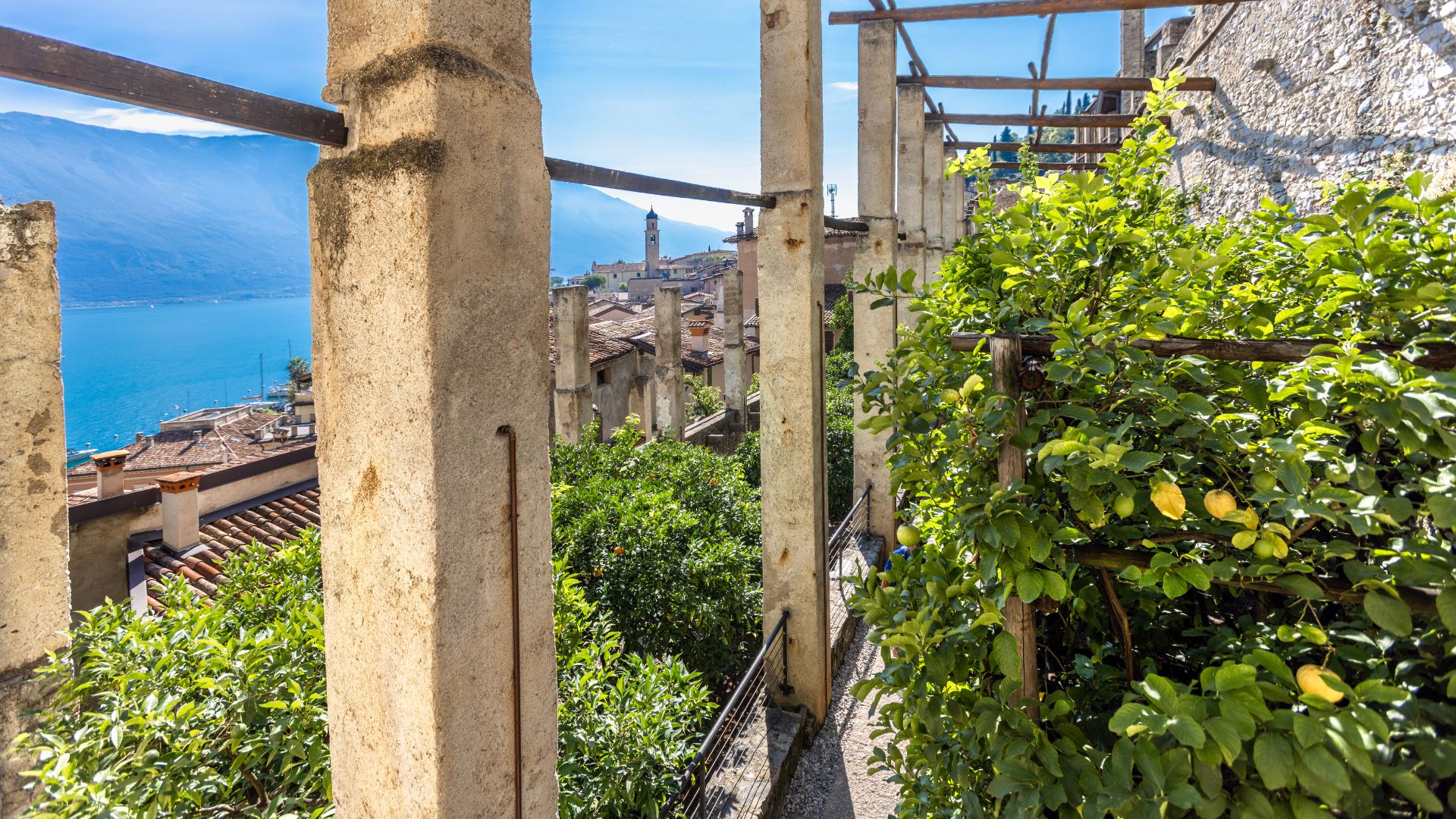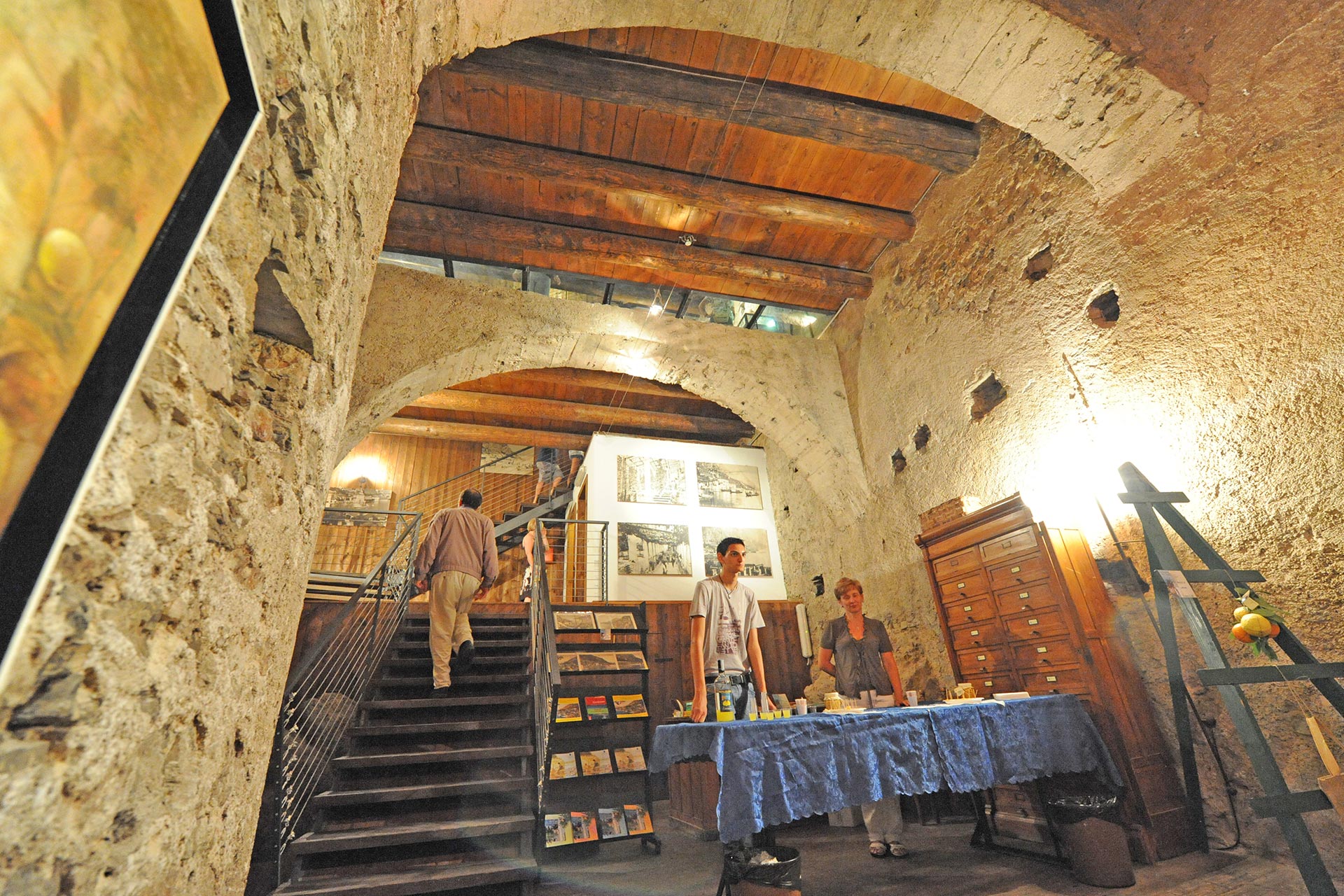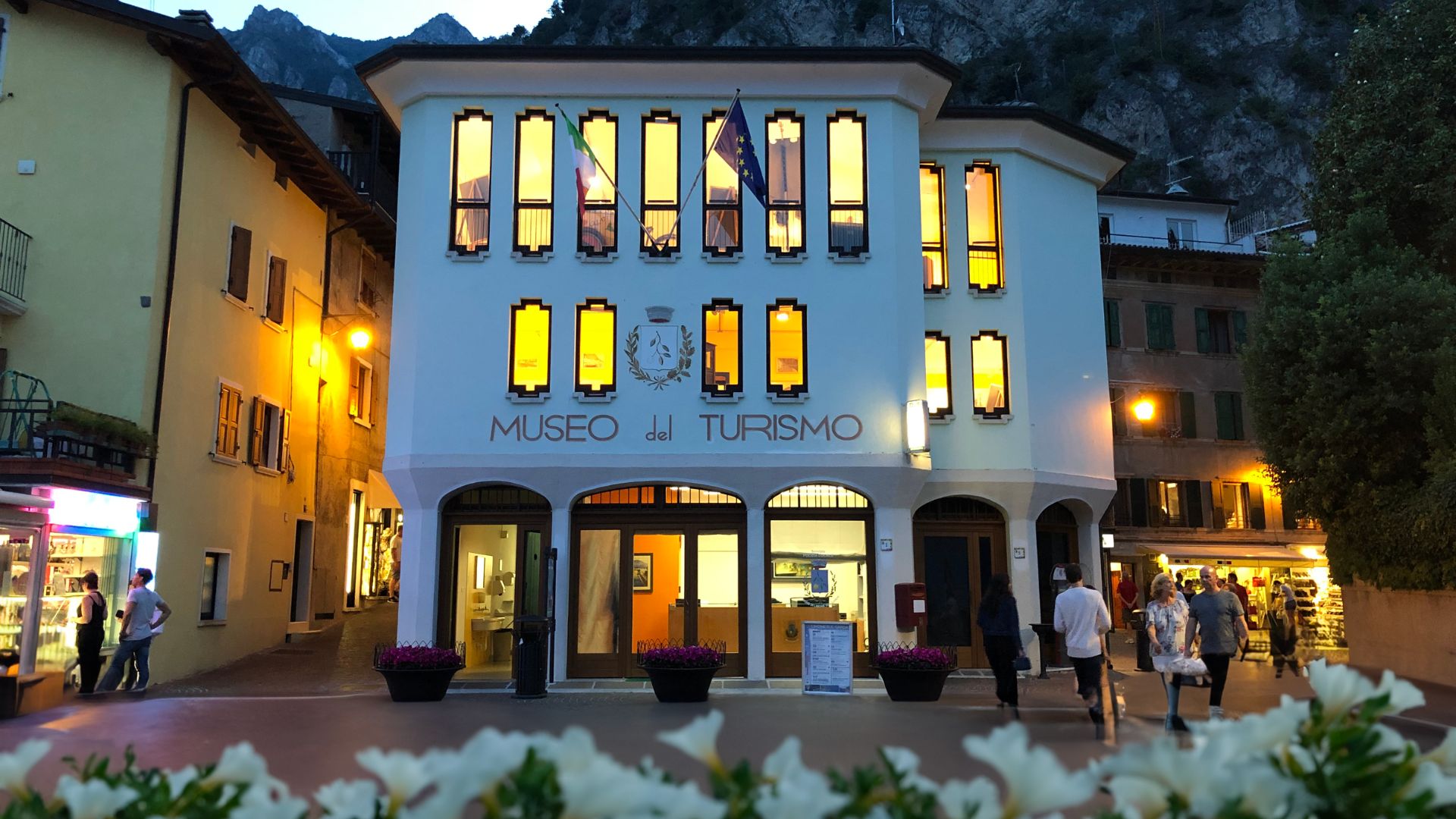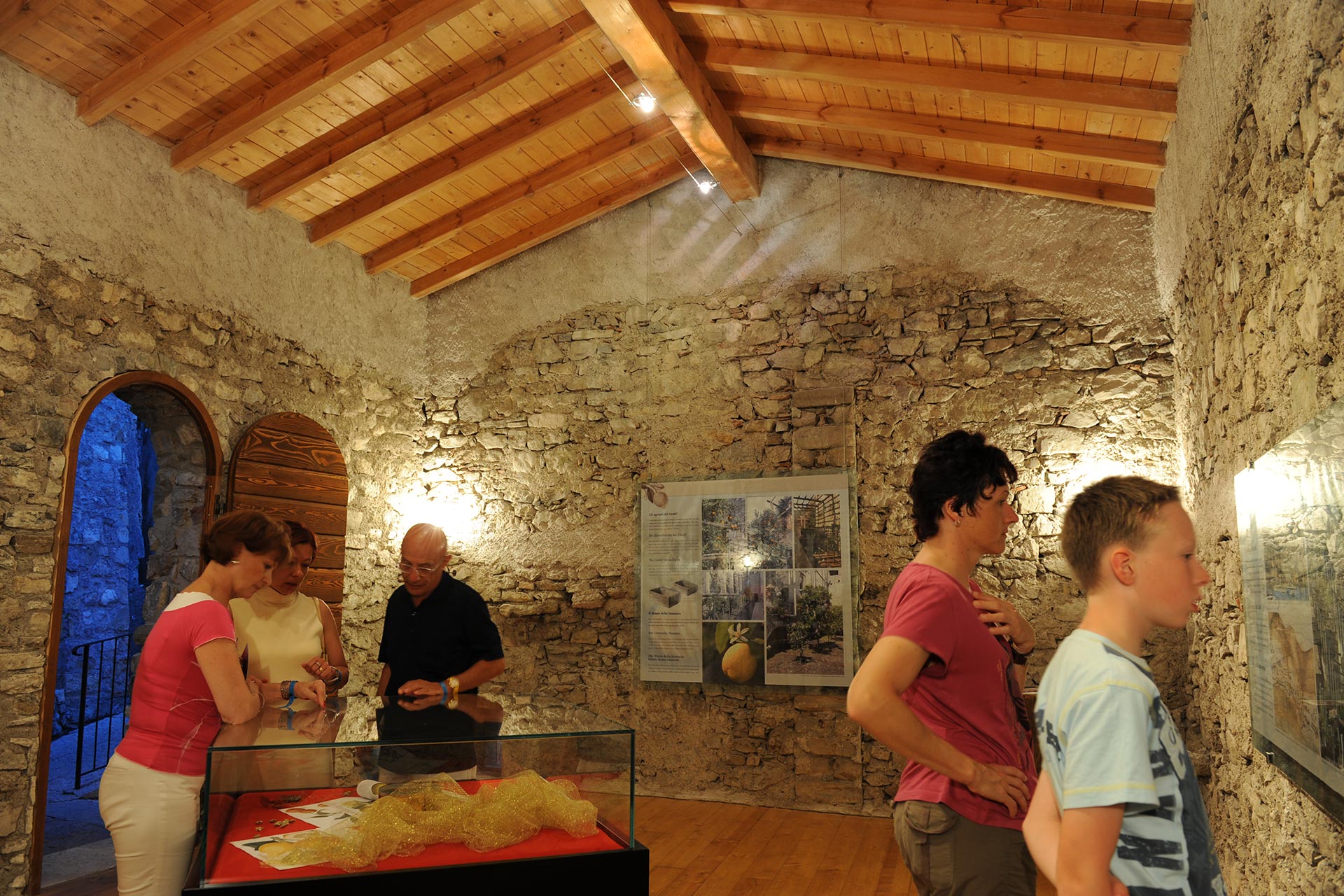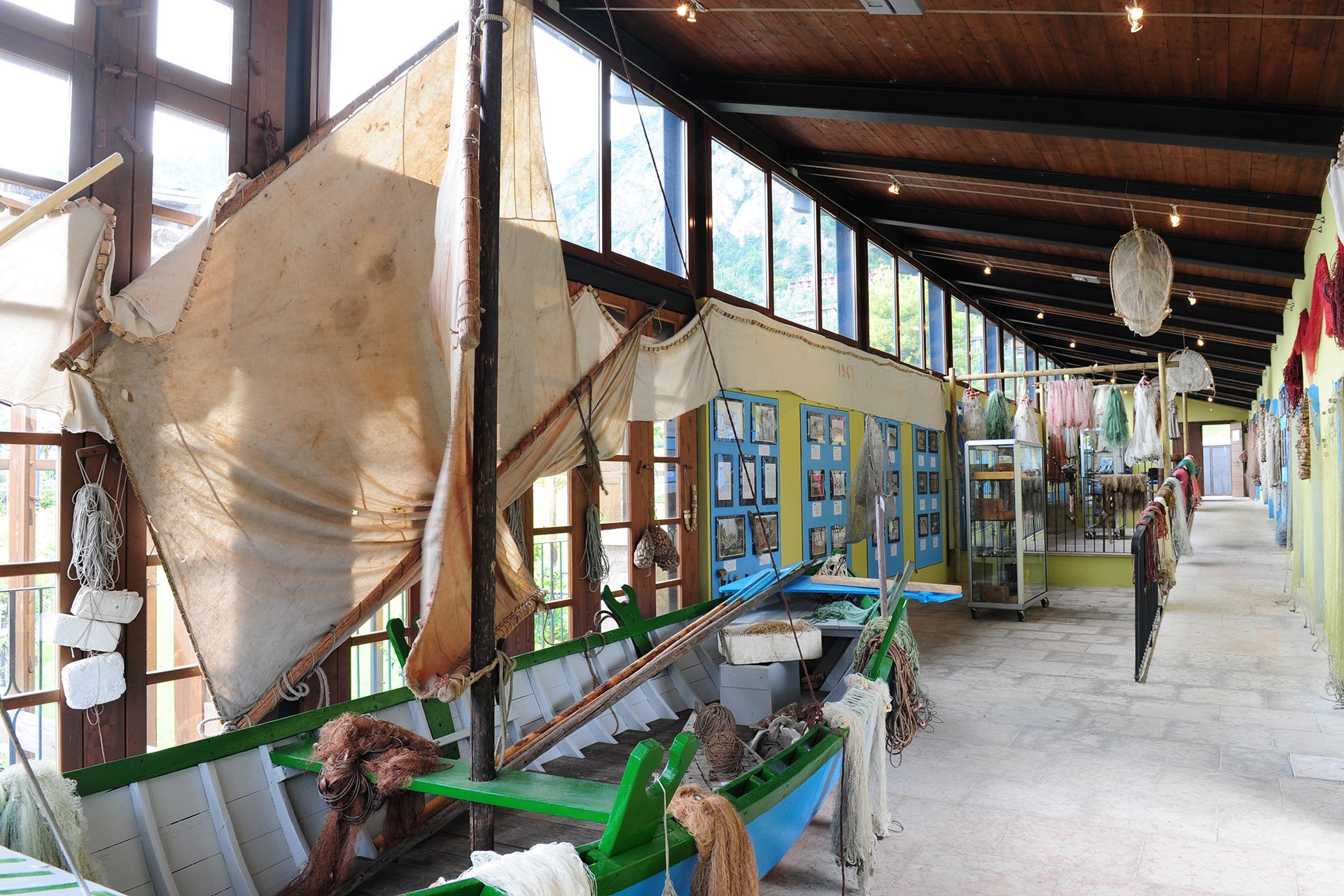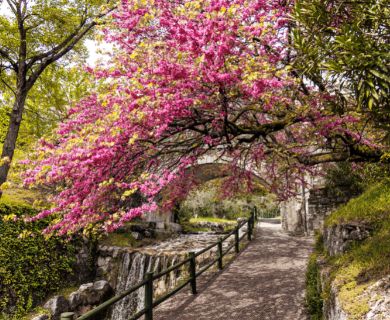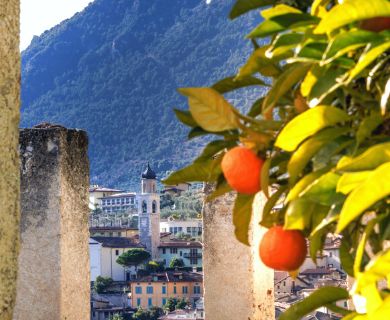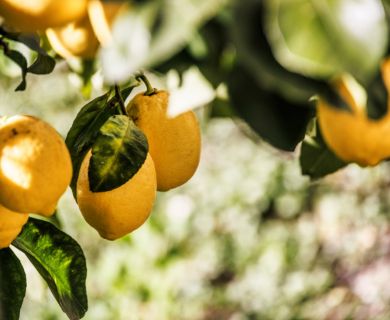Facing the sun to catch its rays, the white pillars, and walls of the unique "Limonaie", the lemon gardens, still stand out along the lake shore. There are only traces of them on the lake between Gargnano and Limone, evidence of a glorious past.
In 1995, the Municipal Administration purchased the "Limonaia del Castèl" with the intention of enhancing this heritage, restructuring it, and putting it back into use, planting over a hundred citrus trees, restoring the terracing and the irrigation system, and arranging the tool sheds, which have also become an educational trail.
To facilitate access to the Limonaia, ceramic tiles have been placed on the streets in the center.
To the north-west of the historic center, leaning against the rocks of the Mughéra, the Limonaia del Castèl is now only part of the large production structure that once reached the Màndola valley from the Mura valley, Pozze Street and Castello Street. The garden, which has a surface area of 1,633 square meters, is divided perpendicularly into two parts by the cùen dela Marches'àna, on which the main casèl is built, with several floors: in the southern part, it extends for a stretch on a single còla, for another on three; in the northern part it extends on four còles, which border northwards with the valèt del Castèl, on which another small casèl is built.
Its construction dates to the early 18th century. It is clear, however, that the lemon house has undergone various alterations over time. The date "15 April 1786", still visible in a water collection well, could refer to the construction or adaptation of the channels in the còle. Other interventions were carried out to raise and move pillars, to raise the walls and to increase the walking surface and the number of floors of the cas'èl. The Limonaia passed from the Amadei family to the Bertoni and Patuzzi families and, in the 19th century, to the Girardi and Polidoro families. On 19 June 1926, the deed was bought by Giuseppe Segala (1889-1975), who had returned to Limone from America after years of hard work as a miner. Four building works were carried out: the first in 1997 for the construction of a wall, the replacement of sparadòs and cantér and the cleaning of the còle; the second in 1999 for the reconstruction of the roof of a cas'èl; the third in 2002-03, thanks to a specific contribution from the Lombardy Region under the "2000-2006 Rural Development Plan", for the conservative restoration of two casèi and two còle. In the winter of 2006-2007, with funds from the Municipal Administration, the works on the casèi/entrance building and the lower terrace were completed. The central cas'èl serves as a link between the terraces and is equipped as a museum-didactic center. In all the còle there are canals for irrigating the plants; the water came from the San Giovanni stream through the Calmèta conduit, which dates to the early 18th century. In the Limonaia, inaugurated on 22 July 2004, about a hundred citrus fruits are grown (citrons, lemons, sweet and bitter oranges, chinottos, grapefruits, mandarins and kumquats).
-
Entrance € 2.00
Children under 10 years old enter for free
Free entry until 30.03.25
The contribution goes towards the maintenance and enhancement of the Limonaia. -
Opening hours 2025:
from 11.01.25 to 30.03.25 open on Saturdays and Sundays from 10 AM to 5 PM, free entry
from 01.04.25 to 31.05.25 open from 10AM to 6 PM
from 01.06.2025 to 30.09.2025 open from 10 AM to 10 PM
from 01.10.25 to 02.11.25 open from 10 AM to 6 PM
For further information, or to book guided tours, please contact the Town Hall office during office hours at 0365 954008.
Lemon trees were first introduced from the Genovese Riviera to Lake Garda in the 13th century by the friars of the convent of San Francesco in Gargnano and were later grown in Maderno and Toscolano. Numerous travelers wrote about it from the 15th century onwards. A curious reference to Limone can be found in Grattarolo's Storia della Riviera di Salò (1599).
In order to protect the plants and fruit from the occasional winter cold, the first Limonaie were built from the 17th century onwards, with walls, pillars, stairs, portals and beams on which boards and glazing were fixed from November to March. It was during the first half of the eighteenth century that the most substantial work was done in Limone, especially thanks to the investments made by the Bettoni family in the Garbéra, Reamòl and Nua gardens. Since then, Limone has been "the town of lemons". The whole of the gulf was marked by the imposing new structures, immortalized in prints and praised in the pages of writers and poets.
Even J. W. Goethe was struck by the landscape of Limone on 13 September 1786, when he was travelling by boat from Torbole to Malcesine: "The morning was beautiful, though cloudy, but calm at dawn. We passed Limone, whose terraced gardens, planted with lemons, have a rich and beautiful appearance. The garden is made up of rows of white square pillars, which are at a certain distance from each other and go up the mountain as steps. Strong beams are placed over these pillars to cover the plants during the winter. The observation and contemplation of these pleasant objects was facilitated by the slow navigation...'.
Limone was the northernmost commercial citrus production area in the world; lemons were exported by the hundreds of thousands, mainly to Germany, Poland, and Russia, providing work and considerable profits.
In the second half of the 19th century, there were signs of crisis, first because of the gum disease (1855), then because of competition from lemons from the southern regions following Italian unification (1861) and the development of transport, and finally because of the discovery of synthetic citric acid. All these factors made lemon-growing less and less profitable; the Great War, with the requisitioning of materials to cover the gardens, and the exceptional cold of the winter of 1928-29 dealt it the final blow.
According to Carlo Simoni, coordinator of the project, "the lemon houses, as well as being a monument to the know-how and environmental expertise of Lake Garda, are in fact the nodes of a network of routes that together constitute perhaps the most significant thematic itinerary among those that can be identified and developed in the area.
In the context of the existing heritage, made up not only of the Maderno and Gargnano complexes but also of other countless and unexpected presences for the visitor (think of the nuclei of lemon houses observable at Sisengla, on Monte di Gargnano, or under Piovere), one must also recall the experiences - decisive from a museum point of view, in that they are alive and operating - of the lemon houses still maintained in activity in Gargnano itself and, in this same center, the potential connected to a partial but innovative use of the complex of the Società Lago di Garda.
It is from this background, differentiated within and yet cohesive in its historical and cultural characteristics, that two cases emerge which can already be identified as the main poles of what we can recognise as the "subsystem" of the lemon houses within the Upper Garda Museum network. The Limonaia del Castèl in Limone, with its strong landscape function right in the center of the village, and the Pra de la fam Limonaia in the Tignale area, which has been a destination for visitors for years and is the site of an ongoing cultivation activity, are proposed as areas for museum design that is up to date in its methods and aims and at the same time able to differentiate the offer. In fact, it is essential that the centers of attraction of the system are coordinated and complementary and, by referring to each other, are - for the tourist as well as for the schoolchildren - the essential stages of a single visit".
